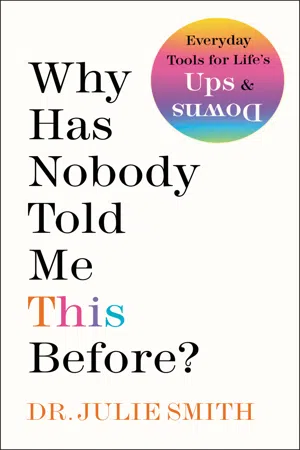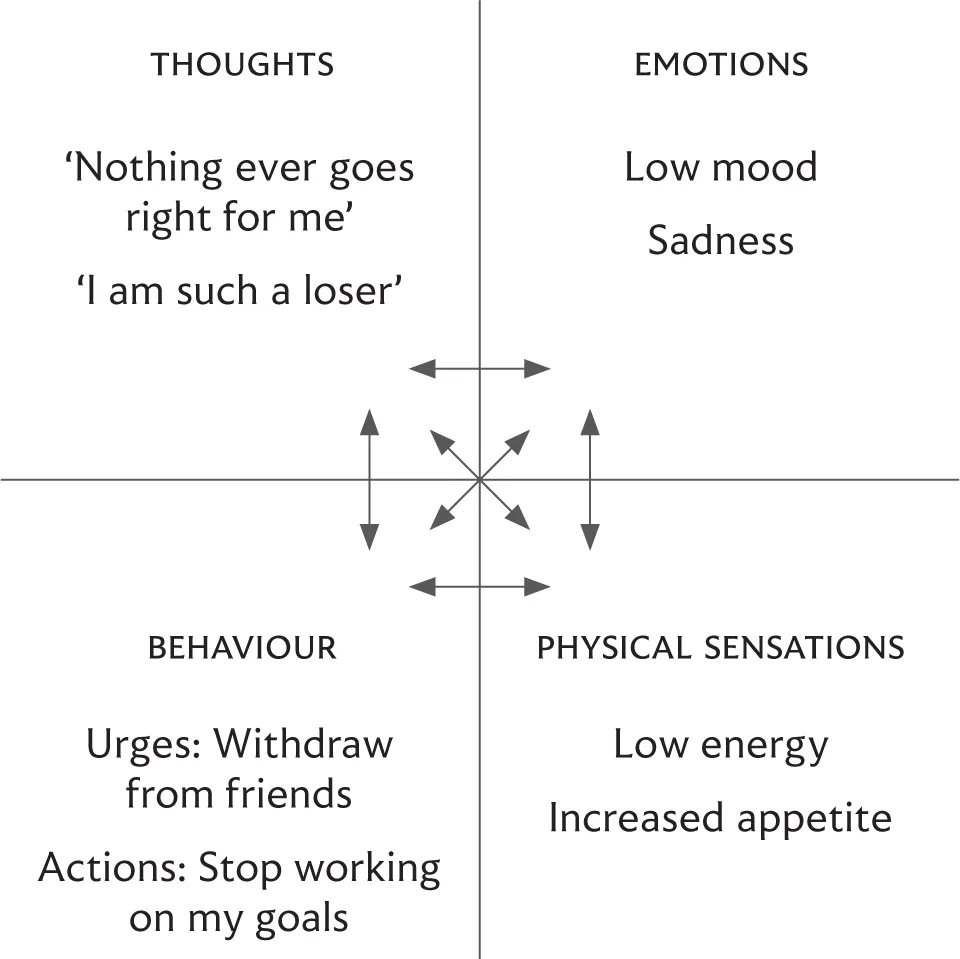Chapter 1
Understanding low mood
Everyone has low days.
Everyone.
But we all differ in how frequent the low days are and how severe the low mood.
Something that I have come to realize over the years of working as a psychologist is how much people struggle with low mood and never tell a soul. Their friends and family would never know. They mask it, push it away and focus on meeting expectations. Sometimes people arrive at therapy after years of doing that.
They feel like they’re getting something wrong. They compare themselves to the people who appear to have it all together all of the time. The ones who are always smiling and apparently full of energy.
They buy into the idea that some people are just like that and happiness is some sort of personality type. You either have it or you don’t.
If we see low mood as purely a fault in the brain, we don’t believe we can change it, so instead we get to work on hiding it. We go about the day, doing all the right things, smiling at all the right people, yet all the time feeling a bit empty and dragged down by that low mood, not enjoying things in the way we are told we should.
Take a moment to notice your body temperature. You might feel perfectly comfortable, or you may be too hot or too cold. While changes in how hot or cold you feel could be a sign of infection and illness, it could just as easily be a signal of things around you. Maybe you forgot your jacket, which is normally enough to protect you from the cold. Perhaps the sky has clouded over and it has started to rain. Maybe you are hungry or dehydrated. When you run for the bus you notice you warm up. Our body temperature is affected by our environment, both internal and external, and we also have the power to influence it ourselves. Mood is much the same. When we experience low mood, it may have been influenced by several factors from our internal and external world, but when we understand what those influences are, we can use that knowledge to shift it in the direction we want it to go. Sometimes the answer is to grab an extra layer and run for the bus. Sometimes it’s something else.
Something that the science has been confirming to us, and something people often learn in therapy, is that we have more power to influence our emotions than we thought.
This means we get to start working on our own wellbeing and taking our emotional health into our own hands. It reminds us that our mood is not fixed and it does not define who we are; it is a sensation we experience.
This doesn’t mean we can eradicate low mood or depression. Life still presents us with hardship, pain and loss and that will always be reflected in our mental and physical health. Instead, it means we can build up a toolbox with things that help. The more we practise using those tools, the more skilled we get at using them. So when life throws us problems that hammer our mood into the ground we have something to turn to.
The concepts and skills covered are for us all. Research shows them to be helpful for those with depression, but they are not a controlled drug that you need a prescription for. They are life skills. Tools that we can all use as we go through life facing fluctuations in mood, big and small. For anyone who experiences severe and enduring mental illness it is always optimal to learn new skills with the support of a professional.
How feelings get created
Sleep is bliss. Then my alarm offends my ears. It’s too loud and I hate that tune. It sends a shockwave through my body that I am not ready for. I press snooze and lie back down. My head is aching and I feel irritated. I press snooze again. If we don’t get up soon the kids will be late for school. I need to get ready for my meeting. I close my eyes and see the to-do list lying on my desk in the office. Dread. Irritation. Exhaustion. I don’t want to do today.
Is this low mood? Did it come from my brain? How did I wake up like this? Let’s trace back. Last night I stayed up late working. By the time I got into bed I was too tired to go back downstairs to grab a glass of water. Then my baby woke up twice in the night. I haven’t slept enough and I’m dehydrated. The loud alarm woke me from a deep sleep, sending stress hormones shooting through my body as I woke up. My heart started pounding and that felt something like stress.
Each of these signals sends information to my brain. We are not OK. So my brain goes on a hunt for reasons why. It searches, it finds. So my physical discomfort, brought about by lack of sleep and dehydration, helped to create low mood.
Not all low mood is unidentified dehydration, but when dealing with mood it is essential to remember that it’s not all in your head. It’s also in your body state, your relationships, your past and present, your living conditions and lifestyle. It’s in everything you do and don’t do, in your diet and your thoughts, your movements and memories. How you feel is not simply a product of your brain.
Your brain is constantly working to make sense of what is going on. But it only has a certain number of clues to work from. It takes information from your body (e.g. heart rate, breathing, blood pressure, hormones). It takes information from each of your senses – what you can see, hear, touch, taste and smell. It takes information from your actions and thoughts. It pieces all these clues together with memories of when you have felt similar in the past and makes a suggestion, a best guess about what is happening and what you do about it. That guess can sometimes be felt as an emotion or a mood. The meaning we make of that emotion and how we respond to it, in turn, sends information back to the body and the mind about what to do next (Feldman Barrett, 2017). So when it comes to changing your mood, the ingredients that go in will determine what comes out.
The two-way road
Lots of self-help books tell us to get our mindset right. They tell us, ‘What you think will change how you feel.’ But they often miss something crucial. It doesn’t end there. The relationship works both ways. The way you feel also influences the types of thoughts that can pop into your head, making you more vulnerable to experiencing thoughts that are negative and self-critical. Even when we know our thought patterns aren’t helping, it is so incredibly hard to think differently when we feel down, and even harder to follow the rule of ‘only positive thoughts’ that is often suggested on social media. The mere presence of those negative thoughts does not mean that they came first and caused the low mood. So thinking differently may not be the only answer.
How we think is not the whole picture. Everything we do and don’t do influences our mood too. When you feel down, all you want to do is hide away. You don’t feel like doing any of the things you normally enjoy, and so you don’t. But disengaging from those things for too long makes you feel even worse. The loop also occurs with our physical state. Let’s say you have been too busy to exercise for a few weeks. You feel tired and low in mood, so exercising is the last thing you want to do. The longer you avoid the exercise, the more you feel lethargic and low on energy. When you are low on energy, the chance of exercising goes down, along with your mood. Low mood gives you the urge to do the things that make mood worse.
Figure 1: The downward spiral of low mood. How a few days of low mood can spiral into depression. Breaking the cycle is easier to do if we recognize it early and act on it. Adapted from Gilbert (1997).
So we get into these vicious cycles easily because all the different aspects of our experience are impacting each other. But while this shows us how we can get stuck in a rut, it also shows us the way out.
All these things are interacting to create our experience. But we don’t experience our thoughts, bodily sensations, emotions and actions all separately. We experience them together as one. Like wicker strands woven together, it’s hard to notice each one individually. We just experience the basket as a whole. That is why we need to get practised at breaking it down. When we do that we can more easily see what changes we could make. Figure 2 shows a simple way to break down your experience.
When we break things down in this way, we can start to recognize not only what we do that keeps us stuck but also what we do that helps.
Most people come to therapy knowing that they want to feel different. They have some unpleasant (sometimes excruciating) feelings they don’t want to have any more and are missing some of the more enriching emotions (such as joy and excitement) that they would like to feel more of. We can’t just press a button and produce our desired set of emotions for the day. But we do know that how we feel is closely entwined with the state of our body, the thoughts we spend time with and our actions. Those other parts of our experience are the ones that we can influence and change. The constant feedback between the brain, the body and our environment means that we can use those to influence how we feel.
Figure 2: Spending time with negative thoughts makes it highly likely that I will feel low in mood. But feeling low in mood also makes me more vulnerable to having more negative thoughts. This shows us how we get stuck in cycles of low mood. But it also shows us the way out. Adapted from Greenberger & Padesky (2016).
Where to start
The first step to begin getting a grasp on low mood is to build our awareness of each aspect of the experience. This simply means noticing each one. This awareness starts off with hindsight. We look back on the day and choose moments to look at in detail. Then, with time and practice, that builds our ability to notice them in the moment. This is where we get the opportunity to change things.
In therapy I might ask someone with low mood to notice where they feel it in their body. They might notice that they feel tired and lethargic or lose their appetite. They might also notice that when they feel low they have thoughts like, ‘I don’t feel like doing anything today. I am so lazy. I’ll never be successful. What a loser.’ They might have the urge to go back to hide in the bathroom at work for a while and scroll through social media.
Once you get familiar with what is going on inside your own body and mind, you can then expand that awareness to looking at what is going on in your environment and your relationships and the impact that is having on your internal experience and behaviour. Take your time getting to know the details. When I am feeling this, what am I thinking about? When I am feeling this, what state is my body in? How was I looking after myself in the days or hours leading up to this feeling? Is this an emotion or just physical discomfort from an unmet need? There are lots of questions. Sometimes the answers will be clear. Other times it will all feel too complex. That is OK. Continuing to explore and write down experiences will help to build up self-awareness about what makes things better and what makes things worse.
Toolkit: Reflect on what is contributing to your low mood Use the cross-sectional formulation (see Figure 2) to practise the skill of picking up on the different aspects of experiences, both positive and negative. You’ll find a blank formulation here that you can fill in yourself. Take 10 minutes and pick a moment from that day to reflect on. You may notice that some boxes are easier to fill than the others.
Reflecting on moments after they happen will help to gradually build up the skill of noticing the links between those aspects of your experience as they happen.
Try this: You can use these prompts to help you fill in the formulation. Or you can simply use these as journal prompts.
- What was happening in the lead up to the moment you are reflecting on?
- What was happening just before ...




